
Beyond the Agent: Why Sovereign AI Demands Neuro-Symbolic Foundations
As defence and national security organisations accelerate the adoption of agentic AI, the question of sovereignty becomes more urgent.In this piece, we explore how neuro-symbolic methods can help restore control by combining neural perception with symbolic reasoning to ensure AI systems act with context, accountability, and alignment.
Within defence and national security, the pursuit of systems utilising “agentic” AI that can act autonomously within defined parameters is accelerating. These systems promise speed, adaptability, and reduced human burden. Yet beneath this promise lies a structural vulnerability. Agentic systems relying on foundation models are performative, not comprehending. They operate through statistical pattern recognition and reinforcement optimisation rather than genuine contextual reasoning. These systems construct mappings between observed inputs and rewarded outputs, but they lack a model of the world in which their actions have meaning. Their apparent “decisions” emerge from correlations across vast data distributions, not from internal representations of intent, policy, or consequence.
In cognitive terms, they are associative, not semantic. They can infer that certain outputs are correlated with positive rewards under specific training conditions, yet they cannot reason about why they occur, what assumptions they rest upon, or how they might generalise under new constraints. Reinforcement mechanisms shape their behaviour toward utility functions, but without symbolic grounding, those functions remain disconnected from the normative, legal, and strategic frameworks that govern defence operations.
The result is systems that imitate decision-making without possessing the conceptual apparatus that actionable decision-making requires causality, abstraction, or intent attribution. They simulate rationality, but they do not possess it. This distinction is not philosophical pedantry; it is operationally critical. The absence of grounded reasoning means that an AI agent may potentially execute an action that is syntactically consistent with its training data yet semantically or ethically catastrophic in context.
For commercial applications, this limitation may be tolerable. In defence contexts, it is not. When the logic guiding autonomous or semi-autonomous systems cannot be inspected, verified, or aligned with national objectives, sovereignty is ceded - not to another nation, but to the opaqueness of statistical inference. The risk is not that these systems disobey orders, but that they faithfully execute them without understanding what they mean. In an environment where context, legality, and ethics are inseparable from action, this kind of blindness represents strategic fragility.
The prevailing response to these risks has been to introduce guardrails; reinforcement constraints, safety filters, and oversight loops designed to keep agentic systems within acceptable boundaries. Yet these guardrails operate upon outputs, not within the data representation. Therefore, they cannot guarantee the system has internalized the why behind its actions. This creates an illusion of control. If the environment shifts (through data sparsity, unanticipated scenarios, or adversarial manipulation) guardrails fail silently. The system continues to act, but the human commanders have lost visibility. In Defence and National Security (D&NS) operations, that loss of explainability translates directly into loss of control and implicitly sovereignty. True sovereignty in AI cannot be enforced externally. Neuro-symbolic methods seek to solve this problem.
Neuro-symbolic systems integrate two complementary paradigms. Neural networks excel at perception: extracting meaning from dense, complex, uncertain data. Symbolic systems excel at reasoning: expressing knowledge as entities, relationships, and rules that can be interrogated and verified. When combined, they allow AI to perceive the world and reason about it aligning to a structured conceptual framework that is human comprehensible. This fusion transforms AI-human teams; mitigating the risk of the human becoming reactive and maintaining their position as a reasoning participant within a mission context.
This principle can form the backbone of sovereign cognitive infrastructure. Knowledge is represented with structure and logical relationships that reflect the human defined of semantics of how defence conceptualizes threat, intent, risk, and response. Neural models feed these frameworks, but the reasoning occurs within controlled, transparent layers that can be inspected, audited, and adapted. This ensures that AI systems remain accountable to human command, even as they operate autonomously. This element of epistemic control should not be underestimated as a core component of sovereignty.
Modern AI models, especially large language and multimodal systems, are trained on globalized data that embed cultural, political, and ethical assumptions. When defence organisations import these systems wholesale, they inherit the value hierarchies and interpretive biases of foreign contexts. Over time, this erodes strategic independence. By contrast, neuro-symbolic methods empower defence to own the representations themselves. Symbolic layers are explicitly designed to reflect national priorities, operational terminology, and doctrinal reasoning. Neural components remain adaptable but are bounded by these sovereign semantics. The result is a system that can learn dynamically while reasoning within the framework defined by its operators.
In the cognitive era, power will belong not to those who deploy the most autonomous systems, but to those who command the deepest understanding of both their systems and their operating environment. To safeguard national security, we must ensure our machines do not merely execute our orders they must think like us. Neuro-symbolic methods represent one way that those building for defence can respect the demands of the customer, however, they are not the only way. Researchers and builders must keep looking for new ways to ensure that we meet our requirements employing the best components of different techniques.









